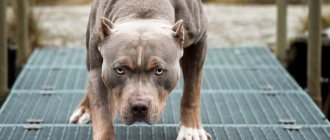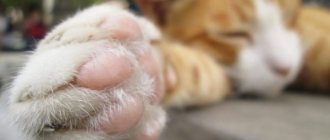Cats are very graceful and flexible animals. Their ability to deftly overcome even very high obstacles is admirable. But sometimes the owner may notice that the cat has a limp and a swollen paw, and there is no trace of grace left. This is a reason to carefully assess your pet’s health status and, if necessary, consult a doctor.
Edema and edema are different
Swelling of cat limbs is many-sided and varied, as are the causes that cause them. A cat's paws may swell:
- in a separate relatively small area - with the so-called localized (local or limited, otherwise local) edema;
- over a large area or over the entire surface of the limb - with generalized (or general) edema.
Often the swelling occurs on one paw of the animal (asymmetrical/asymmetrical edema), less often - on two at once (symmetrical edema).
Photo gallery: types of paw edema in cats
Localized swelling occurs in a relatively small, localized area of the cat's paw
Generalized edema covers a significant area of the animal's limb
Symmetrical swelling appears on both legs of the pet at once
Moreover, in most cases, just by the appearance and location of the swollen areas, one can assume what caused their appearance. Moreover, swelling of the paws characteristically affects the behavior of the animal and is often accompanied by additional specific symptoms.
Pain relief for cats
Most injuries cause the cat to experience severe pain. The owner can independently reduce it by using pain relief therapy. Special veterinary drugs ketofen or nalbuphine are well suited for this purpose. But it is better not to give such popular painkillers as baralagin and analgin, especially in tablet form, to a cat, because they cause severe salivation in the animal. As a last resort, you can inject analgin by injecting 0.4 ml intramuscularly (dose for an average cat).
Also, in case of injury, traumatic shock is possible, one of the manifestations of which is vasospasm. This spasm has a very bad effect on the liver and kidneys. It can be removed with anti-shock therapy. The affected animal should be given corticosteroid drugs, for example, prednisolone (0.3-0.5 ml intramuscularly). But injections should only be considered as an emergency aid. At the veterinary clinic, anti-shock therapy will be continued using drip infusion.
Let's remember about rabies. Cats get rabies in the same way as dogs, so they also need to be vaccinated. It is very important that owners do not forget about this. Rabies can be transmitted to an unvaccinated cat even through a minor bite, and the owner or staff of the veterinary clinic can become infected from it. That is why, when going to the doctor, do not forget to take the animal’s veterinary passport with you. If a cat does not have a rabies vaccination, then the veterinary clinic may refuse to accept it, especially if the animal has a biting laceration received from an unknown location. The safety of people comes before the desire to save the injured animal. Moreover, many cases of rabies are registered in the Moscow region.
Calm, only calm: we observe and inspect
The first thing to do if your furry dog has a swollen paw is to observe his behavior. Don't panic and remember: in the process of monitoring your pet, you should get all the useful information possible. It is important for you to understand:
- whether the animal is in pain;
- is he afraid to lean on his swollen paw?
- Is your pet limping?
- has the cat become less mobile?
- whether he experiences atypical stiffness in movements;
- Is the animal bothered by itching?
At the next stage, you need to carefully and carefully examine the sore paw, and then the entire pet. This will reveal additional symptoms:
- the presence of open wounds and suppuration in the area of edema;
- changes in skin color in swollen areas (redness, paleness, or blueness);
- local temperature change;
- the appearance of peeling, dandruff, unpleasant odor;
- increased salivation and watery eyes of the animal;
- soreness in areas adjacent to the swollen body.
Peeling skin on a swollen area of a cat's paw is an additional symptom that should not be ignored.
It is important to remember that when conducting such an examination there are no trifles: if you contact a specialist, any deviation from the norm you notice (even the most insignificant) can help in making the correct diagnosis.
Your further actions will directly depend on the results obtained from observing and examining the cat.
Why is a cancerous tumor on the paw dangerous?
If you notice any strange swelling, it is recommended to contact your veterinarian, especially if you notice the growth of an unusual lump.
Even a very experienced specialist is unable to determine the nature of the tumor by eye; the stage and advanced stage of the cancer can only be determined using histological examination.
Cancerous tumors are characterized by the rapid growth of abnormal cells that grow together with surrounding healthy tissue. The main danger is their ability to give metastases at stages 3 and 4, which are first found only in the lymph nodes, and then penetrate into all internal organs with the lymph flow.
Once in a new location, cancer cells begin to rapidly divide and destroy healthy tissue, releasing poisons and toxic waste products. Toxins provoke exhaustion and neurological symptoms; in the end, the sick animal faces a painful death from disruption of the functioning of all vital organs.
About causes and consequences: what to do next
What can be discovered when examining a swollen cat's paw, what possible cause would the identified symptoms correspond to, and how can you help your furry friend?
Table: possible symptoms, causes and treatment for swelling of the cat’s paws
| Results of observations of the cat | Paw examination results | Additional symptoms | Possible cause of swelling | What to do |
| The animal is in pain and does not step on its paw | Mechanical damage to a limb (paw is broken, bitten, cut, dislocated, etc.) |
| Injury |
|
| The animal is in severe pain and drags its paw | General asymmetric edema, no mechanical damage |
| Disease or pathology of blood vessels, thrombosis, heart disease |
|
| The animal experiences acute pain that turns into itching | General or local asymmetric edema, no mechanical damage |
| Insect bite (wasp, bee) |
|
| The animal is lethargic and in severe pain | General asymmetric edema, no mechanical damage |
| Lymphadenitis | Seek help from a specialist: treatment should be aimed at combating the cause that caused the inflammation of the lymph node; Only a professional can determine this reason with the help of special studies. |
| The animal does not experience pain (or almost no pain), but suffers from itching | General asymmetric or symmetrical edema, no mechanical damage |
| Allergic reaction |
|
| The animal has a limp and moves stiffly | Local asymmetric edema, no mechanical damage |
| Joint disease (arthrosis, arthritis) | Seek help from a specialist: the doctor will prescribe a course of antibiotics, a suitable painkiller (if necessary) and select the correct dosage of special nutritional supplements - glucosamine and chondroitin. |
| The animal does not experience pain or visible discomfort | General symmetrical edema |
| Disease of the internal organs (most often the heart or kidneys) | Contact a specialist for a diagnosis and treatment. |
| The animal is not in pain, but has become inactive | General asymmetric edema | The paw has greatly increased in size | Mammary cancer | Contact a specialist for a diagnosis and treatment (in most cases, surgery). |
| The animal is not in pain, but has become passive, may cough and refuse food | Local asymmetric edema |
| Mycosis (fungal infection) |
|
| The animal does not experience pain or visible discomfort | Local symmetrical or asymmetrical swelling of the paw pad |
| Plasmacytic pododermatitis | Seek help from a specialist: he will conduct the necessary research and prescribe antibacterial (if necessary) and hormonal therapy. |
| The animal is limping or dragging its paw, its gait has changed | Local asymmetric edema |
| Abscess (purulent infection) | Seek help from a specialist: he will open the abscess, wash the wound with a disinfectant solution, remove dead tissue, stitch the wound, provide the necessary drainage and prescribe a course of antibiotics. |
Thus, if a cat’s paw is swollen, the owner of the animal should not rely solely on his own knowledge and skills: in this case, the help of a veterinarian is necessary. Too serious reasons can be hidden even behind minor swelling; the risk to the animal’s health is too great. After all, even a simple wasp sting in exceptional cases can cause anaphylactic shock. So a visit to a specialist is not too high a price to pay for the well-being of your pet.
And under no circumstances should you squeeze out an abscess while trying to rid your cat of an abscess on your own: manipulations carried out unprofessionally and in unsterile conditions can cause sepsis (blood poisoning).
Only a specialist can open an abscess and remove pus from it without endangering the health of the animal.
How is the treatment carried out?
The pet must be treated according to the system chosen by the specialist, taking into account the diagnosis. A limb can swell for many reasons, so the owner should take care of preliminary diagnosis and do it as soon as possible. If the swollen paw is very inflamed, the problem is most likely an infection. In this case, the animal requires antibiotics or even surgical care.
The dog's muzzle is swollen on one side: causes
Important! You can alleviate his condition before going to the clinic with the help of cold compresses.
If you have an allergy, give an antihistamine tablet; a fungal infection will require urgent use of an antifungal agent. When swelling appears due to venous stagnation, arthritis, kidney disease, heart disease or liver disease, the underlying disease must first be treated. You should not try to treat your pet yourself or give it medications without first consulting a specialist. Edema is a symptom of many serious diseases that require urgent treatment.
Video
Why is it important to find “your” doctor?
Unfortunately, sometimes the cause of swelling of a cat's paw can be a completely ordinary visit to the veterinarian. The first time I encountered such a situation was when my friend was preparing her Sphynx to move to a distant country. By all indications, the cat was absolutely healthy, but the rules required some kind of special blood test. At the veterinary clinic, blood from the vein was taken for analysis without any problems and a pressure bandage was applied to the injured paw to prevent the formation of a hematoma. Everything was done according to the rules, but they forgot to warn the owner that the bandage needed to be removed in about an hour. And my conscientious friend, deciding that it was better to be safe than sorry, left her paw wrapped until the morning (it was in the evening). And early in the morning it turned out that the long-suffering cat’s limb was twice as thick as it was the day before. Fortunately, nothing irreparable happened: it did not lead to tissue necrosis, the paw remained warm and retained sensitivity. So periodic massage and a loose bandage of alcohol-soaked gauze (recommended by another veterinarian) reduced the swelling by lunchtime. The second case directly affected my pet: during the drip administration of vitamins, a poorly secured catheter moved, and the drug went under the skin (instead of a vein). The paw was swollen, any touch to it caused pain, the baby refused to eat. A repeat visit to the veterinarian and a tight bandage with magnesium sulfate applied for an hour and a half corrected the situation. And this time, fortunately, there were also no serious consequences (in the form of an abscess, for example). As it turns out, such cases happen periodically. What can you do: cats are far from the calmest and most obedient patients. However, whatever you say, the doctor’s qualifications also play an important role. Therefore, do not be lazy to make inquiries and find a truly good specialist for your pet (if you value his health, of course). Believe me: a visit to the veterinary clinic closest to your home is not always the right step.
Pretense
Sometimes it happens that the animal has no visible injuries, but the cat still limps on its front leg. The reason in this case may simply be the nature of the animal. A pet whose paw is slightly pinched or, for example, stepped on, may be offended. In this case, the cat, even if it does not feel any discomfort in its paw, begins to limping demonstratively only in order to express its indignation to its owners.
If the lameness is simply emotional, there will most likely be no damage to the animal's paw. Moreover, after a couple of hours the cat will get tired of playing, and he will stop limping.
Hygiene procedures
It will also be necessary to master a number of hygiene procedures that are aimed at reducing the risk of pododermatitis. Among them:
- regular use of protective ointments and creams
- washing paws with soapy solutions after walking outdoors
- trimming claws with your own hands using a nail clipper or in a grooming salon
It is important to understand the fact that the disease is very insidious and dangerous. It is much easier to prevent it than to cure it, and then look for ways to eliminate its many unpleasant consequences. If the owner monitors the condition of the animal, he will protect him from risk and provide reliable health protection.











